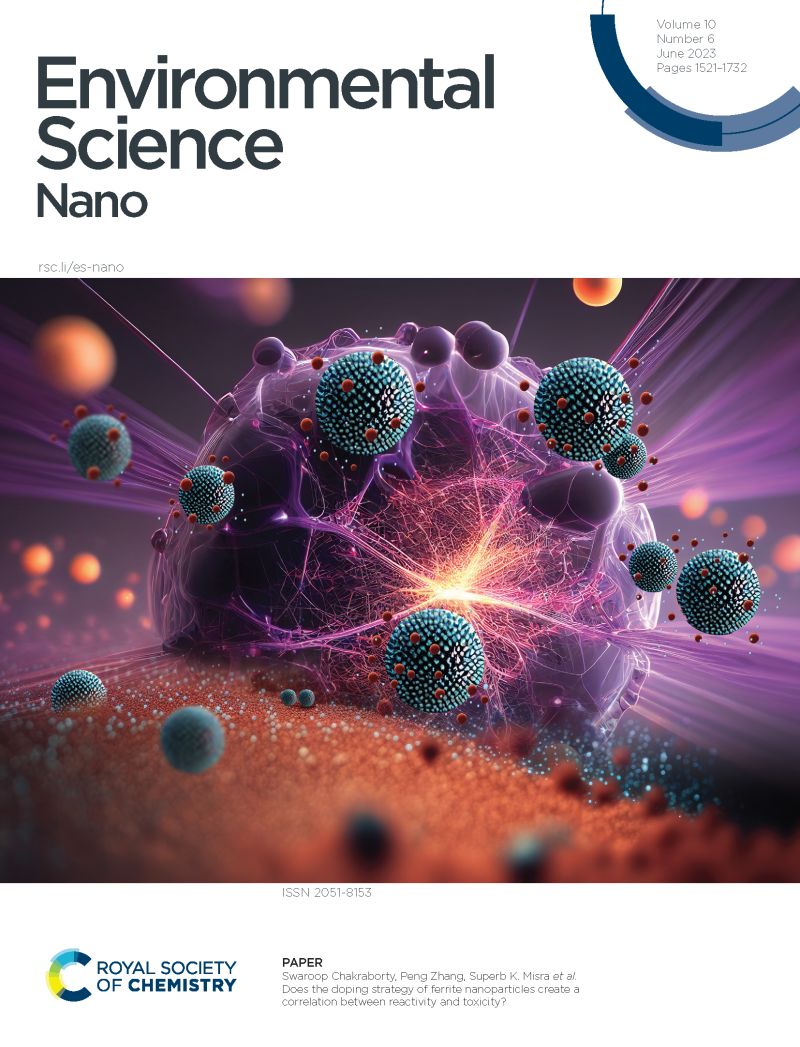氧化石墨烯与纳米fe3o4复合增强黑麦草根系还原性的研究
IF 5.8
2区 环境科学与生态学
Q1 CHEMISTRY, MULTIDISCIPLINARY
引用次数: 0
摘要
石墨烯衍生物是21世纪发展最快的纳米材料。氧化石墨烯(GO)用途广泛,通常以复合材料的形式使用,不可避免地会进入环境。然而,对植物生理参数和代谢的潜在影响,特别是浓度依赖性影响的研究仍然有限。在本研究中,通过根部施用四种浓度(0、10.0、100和500 mg L−1)的氧化石墨烯/Fe3O4(实验室制备的氧化石墨烯和纳米氧化铁复合材料),研究对水培黑麦草(Lolium perenne L.)生理参数的影响。扫描电子显微镜、元素映射和动态光散射(DLS)显示,氧化石墨烯/Fe3O4高度聚集并带负电荷,使得该复合材料难以进入植物细胞。结果表明,低、中浓度(10.0 mg L−1和100 mg L−1)氧化石墨烯/Fe3O4提高了黑麦草根的还原性,并催化H2O2还原。透射电镜(TEM)和黑麦草根系铁含量分析表明,氧化石墨烯/Fe3O4以浓度依赖性的方式促进了根系铁的积累。逆转录- qpcr结果显示,适当浓度的GO/Fe3O4显著下调脯氨酸合成相关基因的表达,上调谷胱甘肽-抗坏血酸(GSH-ASA)循环中lpclc、LpGR、lpst6和LpDHAR的表达。这些发现为利用氧化石墨烯/Fe3O4调控黑麦草的生理过程提供了依据。本文章由计算机程序翻译,如有差异,请以英文原文为准。

Graphene oxide composited with nano-Fe3O4 for enhancing root reducibility in ryegrass (Lolium perenne L.)
Graphene derivatives are the fastest developing nanomaterials of the 21st century. Graphene oxide (GO) is versatile and is usually used in the form of composite materials and is inevitably introduced into the environment. However, studies on the potential effects on plant physiological parameters and metabolism, particularly concentration-dependent effects, remain limited. In this study, four concentrations (0, 10.0, 100, and 500 mg L−1) of GO/Fe3O4 (a laboratory-made graphene oxide and nano ferroferric oxide composite) were added to hydroponic ryegrass (Lolium perenne L.) via root application to investigate the impact on physiological parameters. Scanning electron microscopy, elemental mapping, and dynamic light scattering (DLS) revealed that GO/Fe3O4 is highly aggregated and negatively charged, making it difficult for the composite to enter plant cells. Results showed that GO/Fe3O4 at low and medium concentrations (10.0 mg L−1 and 100 mg L−1) increased ryegrass root reducibility and catalyzed H2O2 reduction. Transmission electron microscopy (TEM) images and the Fe content of ryegrass roots indicated that GO/Fe3O4 facilitated root accumulation of Fe in a concentration-dependent manner. Reverse transcription-qPCR results demonstrated that an appropriate concentration of GO/Fe3O4 significantly down-regulated the expression of genes associated with proline synthesis and up-regulated LpGCLC, LpGR, LpGST6, and LpDHAR in the glutathione–ascorbic acid (GSH–ASA) cycle. These findings provide a basis for the use of GO/Fe3O4 in modulating physiological processes in ryegrass.
求助全文
通过发布文献求助,成功后即可免费获取论文全文。
去求助
来源期刊

Environmental Science: Nano
CHEMISTRY, MULTIDISCIPLINARY-ENVIRONMENTAL SCIENCES
CiteScore
12.20
自引率
5.50%
发文量
290
审稿时长
2.1 months
期刊介绍:
Environmental Science: Nano serves as a comprehensive and high-impact peer-reviewed source of information on the design and demonstration of engineered nanomaterials for environment-based applications. It also covers the interactions between engineered, natural, and incidental nanomaterials with biological and environmental systems. This scope includes, but is not limited to, the following topic areas:
Novel nanomaterial-based applications for water, air, soil, food, and energy sustainability
Nanomaterial interactions with biological systems and nanotoxicology
Environmental fate, reactivity, and transformations of nanoscale materials
Nanoscale processes in the environment
Sustainable nanotechnology including rational nanomaterial design, life cycle assessment, risk/benefit analysis
 求助内容:
求助内容: 应助结果提醒方式:
应助结果提醒方式:


